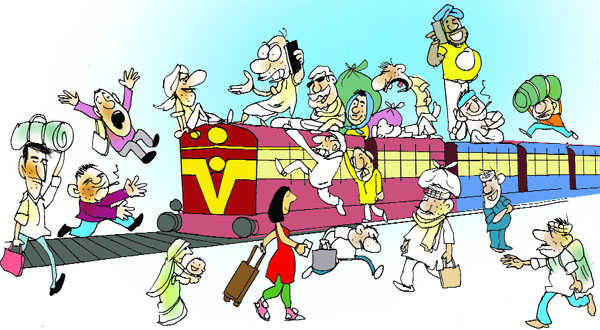Bhartendu Kumar Singh
Every year, Dussehra to Chhath is a crazy time for Biharis in other parts of the country. Most of them visit Bihar during this period. There are at least 50 lakh Biharis in Delhi alone. A vast majority is forced to travel in over-crowded general compartments of Indian Railways. Contemporary Bihar reflects the plight of these people as well as their villages that are empty for most time of the year.
Bihar goes downhill from no. 5 spot
In 1947, Bihar was fifth most developed state of the country. However, the skewed development policy adopted in last 70 years has resulted in ‘development of underdevelopment’ pushing Bihar on a regressive trajectory. Neither agricultural development has taken place in Bihar nor have industries come up. The archival industries like sugar mills set up by British are either closed or running in losses. Bihar that boasted of having early experience of railways is yet to benefit completely from the uni-guage project of Indian Railways. The education system has collapsed, best reflected in eight per cent result of board exams in 2017.
Village after village in Bihar, therefore, has suffered from ‘push and pull’ factors leading to outward migration at every possible level: students, professionals, and skilled and unskilled labour. There was a time when the villages in Bihar had a self sustainable economy. Today, they resemble ‘ghost villages’ with the working population having migrated to other parts of the country. Go to any village and you will find only old people looking after female and infant population. Many of those who stay back also seek outward migration on a seasonal basis.
Hapless migrants
The hapless migrants enter at the lowest strata of society in urban conglomerations like Delhi and work almost everywhere to earn their livelihood. Many of them may have expansive houses in their native villages, but are forced to live in the most compelling circumstances elsewhere.
Also, for many of these migrant class people, Delhi and other metropolitan set ups have become permanent abodes since there is nothing at home to pull them back. They continue to live in a system where they do not have access to sanitised life, quality education and scope for upward mobility.
What is true of Bihar is also true of under-developed states like West Bengal, Odisha, and much of the north-east. Our development model has led to growth and job opportunities only in select states and cities. The so-called regional balance approach in development has been at best a paper tiger. The easy availability of cheap labour from the poor states has only added to the attraction index of these developed pockets.
Take offices to tier three cities
Can something be done to rationalise this flawed model of development? Perhaps, yes! Imagine a scenario where an office with 100 staff is opened in Delhi. Along with these 100, as many as 500 others would be compelled to live in already crowded Delhi. For the office commuters, a fair portion of their daily life would be spent jostling for space on choked Delhi roads.
It is debatable if such offices add to government or business convenience but it certainly compels hundreds of people to live sub standard lives in Delhi.
Now take this office out of Delhi to a tier three city in a backward state. A new office would enable the development of local infrastructure; provide indirect employment to dozens and enable a meaningful life to employees along with their families through incentives in the form of clean air, green vegetables and spacious houses. Above all, communication distances are short along with cheaper cost of living.
Many offices can be taken out of Delhi and other metro cities, both in government and in private sector, to tier two and three cities without affecting the work. The ongoing project to set up a hundred plus ‘smart cities’ only makes this task easier.
It is time to rethink our development (in)securities emanating from big cities and develop our villages and small cities so that skilled and unskilled people can be deployed in local conditions. Unless this is done, the ghost villages would continue to haunt India’s growth story.
A case: Develop Madhubani
Take the example of Madhubani district of Bihar. The brief profile for the district issued by the Ministry of Micro, Small and Medium Enterprises (MSME) in the Government of India is a tell-tale picture with virtually no industrial activity. The entire district has only one major industrial unit, a sugar factory, closed for last three decades.
However, it does have potential for growth and development. Madhubani is famous for its Mithila paintings. If a dedicated school is opened for training of artists and facilitating commercial marketing of their paintings to the outside world, thousands of womenfolk can hone their skills and earn better living for themselves. Madhubani is also known for water berries but there is little incentive in form of skill development to proliferate this cottage industry on a commercial scale. Madhubani has many historical places linked to Sita and Rama that can be developed as tourist circuit. These are representative examples of developing local potential that can arrest outward migration to a great extent.
The writer is with the Indian Defence Accounts Service. The views are personal.
Unlock Exclusive Insights with The Tribune Premium
Take your experience further with Premium access.
Thought-provoking Opinions, Expert Analysis, In-depth Insights and other Member Only Benefits
Already a Member? Sign In Now










